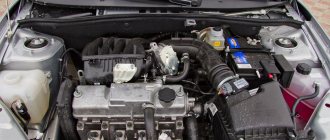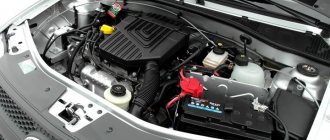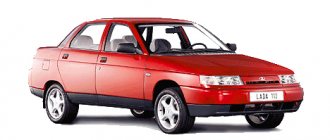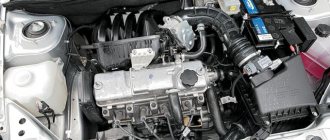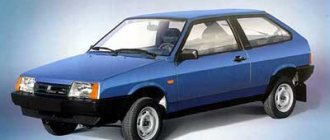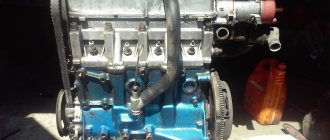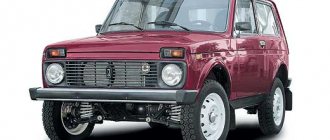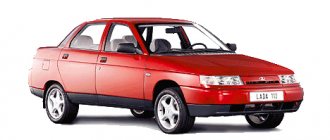Motor 11189 is a widespread power unit from the Kalina family, which is installed on such car models as Lada Vesta, Lada Granta, and more recently on Lada Largus. Engine 11189 was first introduced back in 2016 and is essentially a modern modification of an earlier version of engine 11186 for the Lada-Largus model. The assembly of this engine is carried out in the city of Togliatti Automotive.
Pros and cons of Lada Largus engines
Let's start with the fact that previously the engine assembly for the Lada Largus was produced by the Renault plant in Spain. Later, K4M engines began to be assembled at AvtoVAZ. This did not affect the build quality; the motors meet all international standards.
The main technical characteristics of engines produced by Renault-Nissan are as follows: Renault-Nissan engines are 4-cylinder, have an in-line arrangement of cylinders. The injection type of the K4M and K7M engines is distributed, electronically controlled. Recommended fuel: Premium-95 gasoline GOST 51105-97. The toxicity standard corresponds to Euro 4.
Among the differences between the Largus engine Renault K4M and the Largus engine Renault K7M:
- compression ratio (K4M - 9.8; K7M -9.5);
- maximum torque (K4M - 148 N.m (at 3750 rpm); K7M -124 N.m (at 3000 rpm));
- volume of oil poured into the engine lubrication system, including the oil filter (K4M - 4.8 l; K7M -3.3 l).
In turn, the main disadvantages of the Renault-Nissan K7M internal combustion engine:
- fuel consumption is quite high;
- sometimes the speed fluctuates at idle;
- valve adjustment should be carried out every 20-30 thousand kilometers;
- lack of hydraulic compensators;
- a broken belt bends the valve; the belt must be replaced every 60 thousand kilometers;
- the likelihood of crankshaft oil seals leaking;
- vibration and noise during operation.
The main advantage is high reliability with proper maintenance and service life (service life of about 400 or more thousand kilometers).
Currently reading
Lada Largus engines 16 valves Renault-Nissan K4M, unlike K7M engines, are much more economical and operate quieter, without vibration. The main disadvantages of the Renault-Nissan K4M internal combustion engine:
- expensive repairs;
- a broken belt causes the valve to bend; the belt must be replaced every 60 thousand kilometers;
- the occurrence of failures during operation was noted;
- floating speed if the fuel is of insufficient quality;
- problems arise in the ignition coil, spark plugs and injectors (result: the unit is damaged);
- frequent failure of the crankshaft position sensor or ignition coil.
Now let's move on to VAZ engines (VAZ 11189 and VAZ 21129 engines). VAZ11189 engines began to be installed on Lada Largus in April 2016. In short, this is a modified version of the VAZ 11186 engine.
The recommended fuel for these engines is AI-92, AI-95 unleaded gasoline. The volume of oil poured into the engine lubrication system, including the oil filter, is 3.5 liters. The toxicity standard for both corresponds to Euro 5.
List of some technical differences between VAZ 11189 and VAZ 21129:
- power supply system (VAZ 11189 - distributed injection with electronic control and VAZ 21129 - injector);
- fuel consumption in the combined cycle: VAZ 11189 - 7 l/100km, VAZ 21129 - 6.6 l/100km.
The main disadvantages of the VAZ 11189 internal combustion engine:
- the need for frequent valve adjustments;
- the occurrence of piston knocking on a cold internal combustion engine;
- clogging of the oil receiver due to the use of low-quality lubricant, as a result, knocking of the crankpins of the crankshaft;
- not too long engine life (on average, about 250 thousand kilometers).
The main advantages of the VAZ 11189 internal combustion engine: simple design and fairly inexpensive repairs (available spare parts). The basic version for the creation of the VAZ 21129 was the ICE 21127.
In this version of the engine, most of the components remained the same; the manufacturer took into account all the disadvantages of its predecessor, the VAZ 21128.
The main disadvantages of the VAZ 21129 internal combustion engine:
- expensive repairs and maintenance;
- the use of expensive lubricants;
- if the timing belt breaks, there is a possibility of engine failure;
- high requirements for replacing elements of the connecting rod and piston group.
Also among the advantages are the convenient location of attachments, as well as the relative reliability of the motors, subject to proper operation, high-quality and timely maintenance.
Malfunctions
| FAULTS | CAUSES |
| The motor does not warm up to the required temperature. | Thermostat is faulty. |
| Knocking and noise in the engine. | 1. Wear of the crankshaft main bearings. 2. Wear of connecting rod bearings. 3. Pistons knock. |
| The engine operates unstably (“speeds float”, “troits”, etc.). | 1. The throttle position sensor is faulty. 2. The valve has burned out. 3. The gasket is broken. |
Engines and transmission
Both manufacturers produce their cars with several types of engines for customers to choose from. In the first case, there are both gasoline and diesel engines with the following characteristics:
- gasoline, volume 1.6 liters with a power of 85 horsepower;
- petrol turbocharged with a volume of 1.2 liters and a power of 115 hp;
- 1.5 liter diesel with a capacity of 75 “mares”;
- diesel, volume 1.5 liters, power 90 “horses”.
The Russian car can have the following power units:
- gasoline, volume 1.6 liters, power 87 hp;
- volume 1.6 liters, petrol, developing power up to 106 “horses”;
- volume 1.6 liters, bi-fuel (gas, gasoline) with a capacity of 106 horsepower.
Station wagons do not have impressive speed characteristics. True, Renault in versions with the most powerful power units has a slightly better figure than Lada. But despite this, cars are more designed for calm drivers. At the same time, they are fuel efficient. And the Russian bi-fuel version is a super economical option for those who travel a lot and are not ready to pay a lot of money for gasoline.
Both cars are available for sale only with a manual transmission.
Both the Frenchman and the Lada Largus are exclusively front-wheel drive cars.
What's the result?
As you can see, the engines on the Lada Largus are classic 8- and 16-valve gasoline units, adapted to Euro 4 and Euro 5. Even taking into account a number of features, these engines turned out to be quite reliable. However, in practice, VAZ engines are somewhat inferior to Renault-Nissan internal combustion engines. At the same time, servicing and repairing domestic units is still cheaper than imported power plants.
We also recommend reading the article about what engine is in the Lada Granta. From this article you will learn about the features, characteristics, as well as advantages and disadvantages of the Lada Granta engine.
One way or another, taking into account the characteristics discussed above, every potential owner of a Lada Largus (especially if a used car is selected) can accurately determine which type of engine is best to purchase this model.
In turn, this will make it possible to meet expectations after the purchase, since it is important to take into account in advance the features of a particular car, the life of its internal combustion engine, the cost of maintenance and repairs, etc.
Comparison of configurations and prices
Renault Docker is sold on the Russian market in three trim levels, differing from each other in power units and the presence of one or another additional equipment. At the same time, for the simplest version in the showrooms of an official dealer they ask about 900,000 rubles. But even in this option, the car will have everything you need to ensure minimal comfort and safety.
Its rival Lada Largus offers buyers a choice of six trim levels: Classic, Comfort, Standard, Luxe, Luxe Prestige and CNG Luxe. The versions differ in engine type and additional options. In addition, the car can be purchased in both a five-seater and a seven-seater version. His opponent does not have such an opportunity, nor does he have such a wide choice of configurations. And a Russian car costs an order of magnitude cheaper than a French one. In its minimum configuration, it can be purchased for about 620,000 rubles. But at the same time, the equipment of such a station wagon will be slightly worse than the French one in the cheapest version.
Conclusion
The VAZ 11189 engine is a fairly common engine that is used in many vehicles produced by AvtoVAZ. Thus, Lada cars of the Grant, Kalina, Largus and Vesta models are equipped with engines marked 11189.
Engine 11189 malfunctions are quite easy to fix yourself. To do this, you need to correctly diagnose and follow the instructions for step-by-step engine repair.
Motor 11189 is a widespread power unit from the Kalina family, which is installed on such car models as Lada Vesta, Lada Granta, and more recently on Lada Largus. Engine 11189 was first introduced back in 2016 and is essentially a modern modification of an earlier version of engine 11186 for the Lada-Largus model. The assembly of this engine is carried out in the city of Togliatti Automotive.
Technical characteristics and reasonable sufficiency
As mentioned above, the new Largus 2022 model year will retain the same filling. Technical characteristics, as before, will imply the presence of two power units of the same displacement, but with different cylinder heads. The eight-valve variant now develops 90 (+3) power and 140 Nm of torque. The engine, which has a 16-valve gas distribution mechanism, produces 106 hp. and 148 Nm. Both engines are paired with a 5-speed manual transmission.
Dynamics and valves
The minimal difference in torque means that when used in urban conditions, the base unit is not much inferior to its multi-valve counterpart. The technical specifications of the Lada Largus state 14.0 seconds acceleration to hundreds, a top speed of 160 km/h, and an average consumption of 8.2 liters per 100 km. The benefits of the 106-horsepower engine will be most felt on the highway, but the maximum capabilities are also low. It will take 13.5 seconds to reach the first hundred, and you will be able to reach 165 km/h. High power is not a hindrance to efficiency, and the passport data indicates 7.9 liters of average gasoline consumption.
Tuning
Literally all production engines that have eight valves are improved according to the same schemes. The VAZ-11189 engine is no exception, the characteristics of which make it possible to quickly modernize the engine.
Popular methods of tuning the power unit:
- Replacing the standard internal combustion shaft with a “Nuzhdin 10.93 (phase 282)” or “OKB Dinamika 108” shaft.
- Equipped with split gear.
- Forming the exhaust using a spider 4-2-1.4. Mounting on top of the receiver cylinder head 5.
- Setting the valve timing.
If the above steps are performed by an experienced specialist, then it is quite possible to increase the engine power to 100 hp. With.
Exterior of compared cars
Some experts are inclined to believe that the body of the Largus is more attractive than that of the Logan. The quality of the coating on both station wagons is excellent, regardless of the model of Renault Logan or Lada Largus. The paint firmly resists road “surprises”.
The dimensions of today's “heroes” Renault Logan or LADA Largus of the comparative test are very similar. In length, Lagrus, with its indicator of 4470 mm, is slightly inferior to the “Frenchman”, whose parameter is 4492 mm.
The advantage of the Lada is the presence of more durable linings around the perimeter of the wheel arches. These protective components are available for all trim levels of the Russian car, which cannot be said about Logan.
In addition, rear linings play their role in Largus, protecting the body from “bombardment” of stones and gravel. The anti-gravel coating here is applied over a larger area, which the French rival cannot boast of.
Renault also does not have a rear windshield wiper, but the domestic station wagon has this convenient and functional element.
The Largus washer fluid reservoir is larger in volume, so the owner is less likely to look under the hood to replenish it. However, this is not an indication that Renault Logan or LADA Largus is actually better.
Specifications
As a platform for the station wagon, the typical Renault-Nissan B0 was used, which made Largus essentially a restyled version of the French five-door analogue, the Logan MCV. It is worth paying tribute to the designers, who, in addition to the advantages available to the “donor,” made an adaptation to Russian conditions.
Let us recall that the proposed platform offers independent spring suspension in the front and semi-independent rear suspension. The front brakes received a disc system, while the rear ones remained drum brakes. The ground clearance in this case reached 14.5 centimeters. Already the factory Lada sits on 15-inch tires with a dimension of 185/65.
The Lada Largus 2022 station wagon is presented on the market in a five-door version. Buyers are offered a choice of five- and seven-door modifications. You will have to pay extra for additional seats. Despite the spaciousness of the cabin, the dimensions remain unchanged:
- length – 4.47 meters;
- width – 1.75 meters;
- height – 1.64 meters;
- wheelbase - 2.9 meters.
The station wagon's curb weight is 1,269 kilograms, and the luggage compartment volume can vary from 560 to 2,350 liters.
Under the hood of a modern Russian design there are two modest 1.6-liter engines. The eight-valve engine is capable of producing 87 hp. with a peak torque of 128 Nm. Doubling the number of cylinders gives additional horsepower, bringing the power to 102 hp. and 148 Nm. The version does not provide for the appearance of an automatic transmission and all-wheel drive. Only “mechanics” and front-wheel drive are offered on the market.
Technical characteristics (table)
| Drive unit | Front |
| Body | Station wagon |
| Gearbox type | MT (5) |
| Engine, volume in liters | 1.6 |
| Acceleration from 0 to 100, s | 14.4 |
| Ground clearance, cm | 14.5 |
| Max. speed, km/h | 158 |
| Length, mm | 4470 |
| Width, mm | 1750 |
| Height, mm | 1670 |
| Number of seats for passengers | 5 |
| Wheelbase width, cm | 290.5 |
| Vehicle weight, kg | 1260 |
| Engine power, hp | 87 |
| Engine torque, N×m | 140 |
| Motor type | In-line, 4-cylinder |
| Manufacturer's recommended fuel | AI-92 |
| Presence of a turbine | No |
| Consumption in the city, l (per 100 km) | 10.5 |
| Consumption outside the city, l (per 100 km) | 6.6 |
| Consumption in mixed cycle, l (per 100 km) | 7.9 |
Options and prices: almost a monopoly
At the moment, for the current Lada Largus there are 4 configurations to choose from. Moreover, the first two versions are available in the cargo-passenger van version without rear glazing. Starting with the second Classic option, by paying an additional 23 thousand rubles to the price, you can get a third row of seats for additional seating for two people. The flagship 16-valve engine is an integral part of the passport data from the third configuration Comfort and higher.
Classic
The basic Classic version starts at 690,900 rubles. Such a low price is due to the minimal set of equipment. The equipment of the initial Largus includes only an adjustable steering column and a 50/50 folding rear sofa. Passive safety is provided only by the front driver's airbag. But for an additional fee, the body can be painted with metallic enamel.
Comfort
The Comfort package next on the list (see tables) is already capable of offering the necessary subsistence level. Buyers of this Lada receive: air conditioning, front power windows, power steering, central locking, heated seats, anti-lock brakes and a folding (60/40) second row. By purchasing Largus Comfort, the owner pleases himself with: a car radio with MP3, hands free and bluetooth telephone, remote control for central locking and a passenger airbag.
Luxe and Prestige
The Luxe version includes such useful things as height adjustment of the driver's seat, heated rear-view mirrors with a servo drive, an on-board computer, parking sensors, fog lights and power windows in the rear. Well, the flagship Prestige package gives the top Lada model only aluminum wheel rims.
Options and prices
Standard
The minimum Standard configuration is available in a 5-seater version for 669,900 rubles. The head optics do not have an overly complex system or content. The lights and headlights received halogen filling, and the rear lighting equipment was reinforced with additional brake lights. The basic version includes heat-insulating glazing and heated rear window, which makes the car suitable for use in the Russian climate. The roof has durable roof rails for carrying cargo. Metallic paint is only available as an option, regardless of trim level. Inside, the driver can adjust the steering column vertically. The difference between the basic version is four headrests, in the rest their number increases to five. There is only one airbag. You will also have to fork out extra money for installing the ERA-GLONASS system. Motion control systems include ABS and EBD. In-cabin amenities are limited to a cabin air filter.
Classic
- power steering;
- mirrors in visors;
- central locking;
- electric drive for front windows;
- ERA-GLONASS.
Comfort
The Comfort package is also available in two seating options. The minimum will cost 672,900 rubles, the extended one will cost 23,000 rubles more. Moreover, this assembly has the ability to connect gas equipment from the manufacturer. For the version with a 106-horsepower engine and a gas-gasoline power system you will have to pay 872,900 rubles
Please note that in this case you can only count on five-person occupancy. The main changes were made to the interior, in particular, electric heating for the first row of seats, a second airbag and air conditioning appeared.
Users have access to a radio, CD player with MP3 support and Hands Free. Instead of two speakers, the “Comfort” version implies the presence of four with the ability to connect AUX and USB devices. A bonus is the height adjustment of the first row seat belts.
Luxe
The Luxe package opens up wide possibilities. The gasoline model will cost 706,900 rubles for 7 seats. Installing HBO automatically raises the price of the five-seater version to 893,900 rubles. The buyer can count on installation:
- front fog lights;
- heated and electric side mirrors painted in body color;
- painted door handles;
- decorative interior trim in black, gray and brown;
- driver's seat height adjustment;
- lumbar support on captain's chairs;
- full package of electric windows;
- remote control;
- rear parking sensors;
- on-board computer.
Luxe Prestige
The previous version came as close as possible to the flagship version Luxe Prestige, costing from 721,900 rubles for versions with a gasoline engine and 899,900 for the version with gas equipment on board. The differences are decorative: aluminum wheels, rear tinting, and a leather steering wheel appear. In September 2022, it became known about the release of a special version of the Lada Largus 2022 Club. The price for the modification is still unknown. The list of additions includes factory tinting and parking sensors. A badge with the hashtag #CLUB will be added to the interior and tailgate.
Options and prices (table)
| Equipment | Volume, l | Fuel | Motor, hp | Box | Dynamics up to 100 km/h, sec | Cool. moment, N×m | Drive unit | Maximum speed, km/h | Consumption in mixed cycle, l | Price, ₽ |
| Classic 5 seats | 1.6 | petrol | 87 | M.T. | 14.4 | 140 | front | 158 | 10.5 | 618 900 |
| Classic A/C 7 seats | 1.6 | petrol | 87 | M.T. | 15.4 | 140 | front | 158 | 10.5 | 648 900 |
| Luxe 7 seats | 1.6 | petrol | 106 | M.T. | 14.5 | 148 | front | 165 | 10 | 708 900 |
| CNG Comfort 5 seats | 1.6 | gas | petrol | 106 | M.T. | 13.5 | 148 | front | 165 | 10 | 874 900 |
| CNG Luxe Prestige 5 seats | 1.6 | gas | petrol | 106 | M.T. | 13.5 | 148 | front | 165 | 10 | 901 900 |
| CNG CNG Luxe 5 seats | 1.6 | gas | petrol | 106 | M.T. | 13.5 | 148 | front | 165 | 10 | 895 900 |
| Standard 5 seats | 1.6 | petrol | 87 | M.T. | 14.4 | 140 | front | 158 | 10.5 | 671 900 |
| Comfort 7 seats | 1.6 | petrol | 106 | M.T. | 14.5 | 148 | front | 165 | 10 | 687 900 |
| Luxe Prestige 7 seats | 1.6 | petrol | 106 | M.T. | 14.5 | 148 | front | 165 | 10 | 723 900 |
| Standard 5 seats | 1.6 | petrol | 106 | M.T. | 13.5 | 148 | front | 165 | 10 | 746 900 |
Prices for configurations are approximate and may vary depending on the region.
Advantages of VAZ-21129 engines
Among the most tangible advantages of this motor, the following points stand out:
- Reducing the consumption of coolant, lubricant, gasoline.
- Rational arrangement of attachments.
- Compliance with environmental standards and Euro 5 requirements.
- The ability to carry out engine overhauls with your own hands in a garage.
- Increasing the declared operational life to 200 thousand km.
- Increasing the reliability and service life of engine 21129.
- Ensuring stable engine speed at idle.
- No need for valve clearance adjustments.
Flaws:
- relatively high cost of engine maintenance;
- the need to use expensive high-quality lubricants from trusted manufacturers;
- carrying out high-budget overhauls;
- increased requirements for replacing elements of the connecting rod and piston group (CPG) and timing chain with new foreign-made equipment;
- high probability of pistons bending if the timing belt breaks.
Thanks to changes in the design of the pistons, the compression ratio was reduced by 0.5. However, this did not lead to the possibility of switching to gasoline with a lower octane number. This is due to the low quality of domestically produced fuel. Experienced drivers do not recommend using cheap gasoline in order to save operating budget.
Technical characteristics of engine 21129:
| Engine capacity | 1596 cm3 |
| Number of camshafts | 2 |
| cylinders | 4 |
| valves | 16 |
| Motor power | 106 l. With. |
| Weight | 92.5 kg |
| Cylinder firing order | 1-3-4-2 |
| Power system type | distributed injection |
| Type of fuel | 95 petrol |
| Environmental requirements | Euro 5 |
| Engine life 21129 | 200 thousand km |
The most common problems with internal combustion engines 11189
The cause of floating engine speed at idle is usually sensor glitches, especially often with regard to the E-gas electronic throttle drive.
Troubleshooting of this power unit is most often caused by failures in the ignition system; much less often this happens due to burnout of valves.
A faulty mass air flow sensor is the most common reason why your car suddenly stalls while driving.
Overheating of this motor is often caused by its rather unreliable thermostat.
The sources of noise and knocking under the hood are usually unregulated valves.
Water pump problems
Due to a design miscalculation, jamming of the water pump or tension roller was fatal for the engine until they began installing plugless pistons in 2022.
How does “Lux / 5 seats” differ from “#Club / 5 seats”
Differences Lada Largus “Lux / 5 seats”
- Fog lights
- On-board computer
- Interior to choose from: black or brown
- Luggage rack on the roof lining
- Trunk tension shelf
- Adjusting the height of the front seat belts
- Driver's seat with height adjustment
- Driver's seat with lumbar support
- Central locking control panel in the key
- Rear electric windows
- Electrically adjustable side mirrors
- Heated side mirrors
- Exterior mirrors in body color
- Exterior door handles in body color
- Wheels 15-inch
- Steel wheels
- Spare wheel 15-inch full size
Differences Lada Largus “#Club / 5 seats”
- Interior black
- Enhanced rear window tinting
- Wheels 16-inch
- Original light alloy wheels
- Spare wheel 15-inch small
What to look for when choosing a Lada Largus
The model appeared on the market seven years ago, so finding a copy with one or two owners is quite possible (every second Largus, according to statistics from avtocod.ru). If there were more owners, it is unlikely that the car was looked after carefully.
Every third station wagon is sold broken or with unpaid fines, every sixth is on lease or has traffic police restrictions. “Largus” are also seen in passenger transportation; in the secondary market this is a third of all cars sold. The same amount is sold in the pledge. We were “lucky” to run into just such specimens.
The first is the “regular” Largus 2022. with mileage 125 thousand km:
The car was issued a duplicate title, and most likely it is a credit car.
The report showed one accident that occurred in 2022, and calculations were made in 2022. The repairs were carried out based on one problem, and their total amount exceeded 744 thousand rubles. Many parts were replaced. Apparently the car was in a serious accident.
The second lien Largus was given in the Cross version. 2022, 14 thousand km, 1 owner, 6 months of operation:
The check did not reveal any other problems other than the deposit:
But even with this problem, it is risky to rent a car. All encumbrances after the purchase will fall on the new owner.
Also read: All Russian cars are bad: truth or stereotype
Maintenance
Carrying out inspection, maintenance and analysis of the characteristics of the 11189 engine is practically no different from the standard procedure for similar VAZ engines. Maintenance includes the following actions:
Change the oil once a year, or every 15,000 km. The specialist must fill in at least 3.2 liters of oil. Inspect and replace spark plugs at every oil change. Periodic inspection of the “heart” of the car to determine transmission and engine oil leaks
If any problems are discovered, it is important to resolve them quickly. Changing the drive belt after a mileage of 40-60 thousand
km.
Repair of power unit components
As practice shows, nothing lasts forever, and neither do the components of VAZ power units. In this part of the article, we will consider the main malfunctions, as well as methods of elimination and repair.
Timing belt or how not to bend valves
Probably the most interesting question for most motorists is whether the valves on VAZ engines bend? As for the VAZ 11189 engine, we can say with confidence that the valves bend when the timing belt breaks. Of course, valves can bend for other reasons, but the most common is considered to be a broken timing belt.
Another question that car enthusiasts ask in car repair shops and on forums regarding the timing belt is how to prevent valve bending? Everything is very simple - change the timing belt and rollers according to the technical recommendations of the manufacturer. Thus, in the maintenance manuals for engine 11189, the recommended belt replacement period is 45-50 thousand kilometers.
What happens if the valve bends? Everything is very simple - after the valve mechanism is bent, such important elements as the valve guide, valve seat, and oil seals fail. Subsequently, it may happen that this problem affects the piston mechanism. In a word, if the valve bends, then you should hope for the best and expect the worst - that is, a major repair.
How to replace the timing belt and rollers:
- First, you need to remove the protective casing.
- Then, we fix the camshaft, but before that it is necessary to set the timing marks.
- Unscrew the tension roller to release the belt.
- Next, we dismantle the belt itself.
- We change the tension roller.
- Reinstall the timing belt.
The procedure for changing the timing belt, at first glance, seems to be quite simple, but not everything is so simple, and not every car enthusiast will be able to carry it out. Therefore, in order not to subsequently bend the valves, it is recommended to contact specialists at a car service center to carry out the procedure.
Water pump malfunction
The water pump circulates coolant through the engine system. This is done for cooling and to prevent the motor from burning out. The failure of such a unit means that further operation of the power unit is impossible, since overheating will occur and the first thing that will be affected is the cylinder head. To avoid this, you should regularly diagnose the part and replace it on time.
